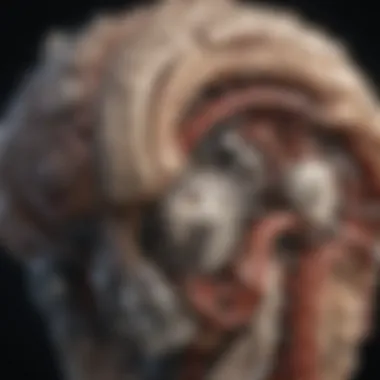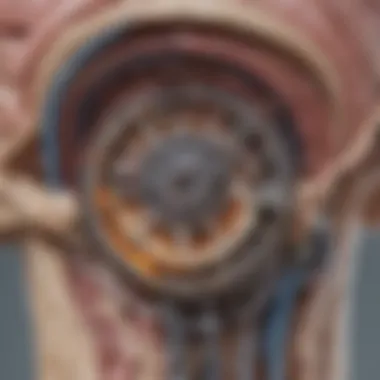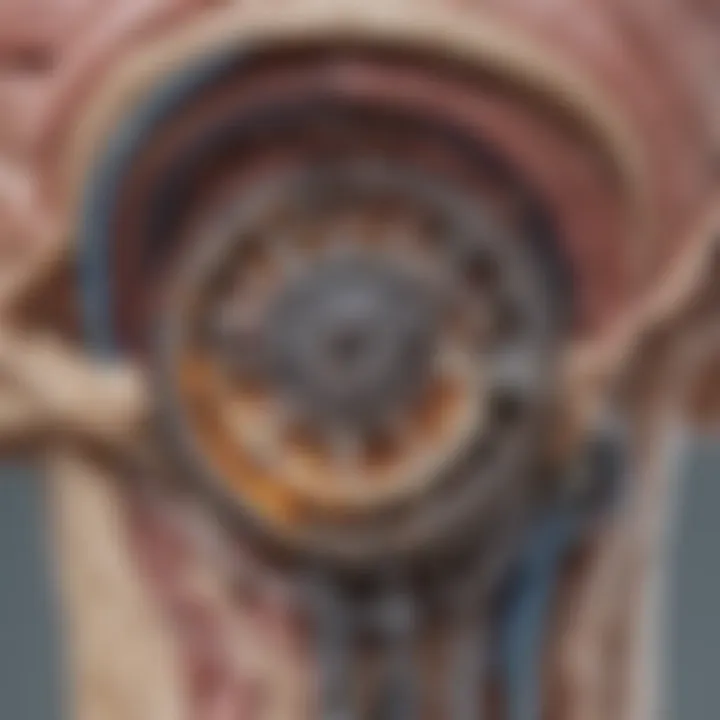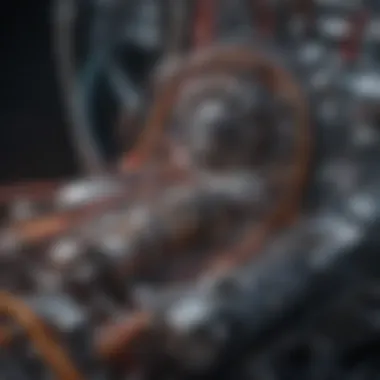Understanding the Motor Cortex: Its Structure and Impact


Intro
When we think about movement, such as throwing a ball or picking up a cup, we often take for granted the intricate workings of the brain that enable us to perform these actions. At the heart of this capability lies the motor cortex, a region that governs voluntary movements. Understanding the motor cortex is key not just for neuroscientists, but also for educators, healthcare professionals, and anyone interested in how the brain orchestrates our motions.
The motor cortex is not a standalone area; rather, it is a network of interconnected regions that interact with various parts of the brain. Through this collaboration, it contributes to our ability to execute complex tasks, adjust movements in real time, and learn new motor skills. Each intricacy of its operation reflects on our understanding of both health and rehabilitation in cases of neural impairment.
In this discussion, we will delve into the structure and function of the motor cortex, exploring its anatomy, operational mechanisms, and its relationship with other brain regions. Additionally, the clinical significance of motor cortex research will be addressed, particularly in the context of neurorehabilitation. Important insights and advancements in targeted interventions aimed at enhancing motor function will also be discussed.
The journey into the motor cortex holds great relevance, as knowledge gained has implications for improving lives, especially those affected by conditions that compromise motor ability. Unpacking the workings of this neural hub is not just an academic endeavor; it can lead to real-world applications that foster recovery and enhancement in motor skills.
Prelims to the Motor Cortex
The motor cortex represents a significant part of our understanding of human motor control. It serves as a command center for voluntary movement, influencing everything from fine motor skills like writing to larger movements involved in sports. Understanding this area of the brain is crucial for anyone keen on delving into human anatomy and neurological function.
The implications of the motor cortex extend beyond basic motor control; they touch on various aspects of health and rehabilitation. This makes it essential for students, researchers, and healthcare professionals alike. The exploration of the motor cortex's structure and function provides insights that play an important role in developing effective treatment strategies for individuals with movement disorders.
Defining the Motor Cortex
The motor cortex can be defined as a part of the cerebral cortex located in the frontal lobe, directly behind the prefrontal cortex. Broadly speaking, it comprises several regions that collaborate in governing voluntary motor activities. The primary motor cortex is the most well-known area, specifically responsible for initiating and controlling movement. However, it is important to understand that the motor cortex is not a monolithic structure; it consists of different areas that serve distinct yet interconnected functions.
One can think of it as a conductor of an orchestra, where various sections must work both individually and in concert to produce a harmonious outcome. The motor cortex helps in translating neural signals into movements by activating a network of muscles.
Historical Context and Discoveries
The story of the motor cortex is as rich as the functions it serves. Historically, the exploration of this brain area has evolved from early anatomical studies to more sophisticated neuroimaging techniques. Initial attempts to map the motor cortex dates back to the 19th century, with pioneering figures such as Fritsch and Hitzig, who conducted electrical stimulation experiments on dogs. These studies revealed the existence of a specific region in the frontal lobe that directly triggered movements.
As time progressed, more discoveries came to light, revealing the intricated relationship between the motor cortex and the body's musculature. With the advent of mid-20th century technologies like electroencephalography (EEG) and, later on, functional MRI, researchers gained a deeper understanding of how the motor cortex activates during various tasks. This growing knowledge base continues to inform clinical approaches to managing neurological disorders.
"The history of the motor cortex is a testament to human curiosity and the commitment to uncover the intricate workings of our own biology."
In summary, exploring the concept and historical context of the motor cortex lays the groundwork for understanding its anatomical structure and functional mechanisms—further enriching our appreciation for the complexities of human movement.
Anatomical Overview of the Motor Cortex
Understanding the anatomical overview of the motor cortex is crucial in unraveling its role in voluntary movements and overall motor control. This region is a nexus for various functions related to muscle coordination and movement execution, making it a fascinating subject of study. By dissecting its structure, location, and specific regions, researchers can better understand clinical implications, such as how injuries can affect movement and what rehabilitation strategies might be effective.
Location within the Brain
The motor cortex is primarily situated in the frontal lobe, lying just in front of the central sulcus. This positioning is pivotal because it allows for direct interaction with several sensory regions, integrating information necessary for coordinated movement. The unique arrangement between the motor cortex and the central sulcus leads to a division between sensory and motor functions. Such spatial considerations give insight into how the brain organizes functionality based on anatomical arrangements. Moreover, certain areas of the motor cortex are mapped correspondingly to various body parts, creating a somatotopic organization.
Structural Layers and Neuronal Types
The motor cortex consists of six distinct layers, each characterized by unique types of neurons and connections. Layers II and III contain excitatory pyramidal neurons, while Layer V primarily comprises large pyramidal neurons that project to subcortical structures.
Key Points about Structural Layers:
- Layer I: Contains few neurons, mostly supporting cells involved in cortical organization.
- Layers II & III: Involved in cortical communication; these layers help integrate signals from various regions.
- Layer V: Most critical for sending out motor signals to the muscles via the spinal cord.
Utilizing this layered structure, the motor cortex can handle incoming sensory information while facilitating outgoing motor commands. Such separation is essential, ensuring a fluid transition between perception and action.
Functional Regions of the Motor Cortex
The motor cortex comprises several distinct functional regions, each specializing in different aspects of motor control.
Primary Motor Cortex
The primary motor cortex is the frontline of voluntary movement control. It is primarily responsible for executing planned movements.
- Key Characteristic: It features a homunculus, a representation of how body parts relate to their cortical counterparts.
- Why It's Beneficial: The primary motor cortex is fundamental for understanding how the brain directs movement, positioning it as a starting point for more complex discussions about movement disorders.
- Unique Feature: Its connectivity with various subcortical areas allows it to integrate diverse sensory input. However, damage here can lead to significant movement deficits, highlighting its importance in clinical discussions about stroke and other neurological disorders.
Premotor Cortex


Adjacent to the primary motor cortex is the premotor cortex, which is crucial for the planning stages of movement.
- Key Characteristic: This area is actively involved in sequencing actions and executing learned movements rather than simple reflexes.
- Why It's Beneficial: Awareness of the premotor cortex's role helps in understanding how complex movements are initiated, providing insights into rehabilitative strategies for stroke patients needing retraining.
- Unique Feature: The premotor cortex has connections to the parietal cortex, allowing it to gather sensory feedback critical for planning motor actions. This can sometimes lead to a disadvantage, as its reliance on sensory information means disruption can severely impact movement planning.
Supplementary Motor Area
The supplementary motor area (SMA) plays an important role in coordinating bilateral movements and the initiation of voluntary actions.
- Key Characteristic: It is particularly active during internally generated movements that do not rely heavily on visual cues.
- Why It's Beneficial: For fields focused on rehabilitation, knowing the role of the SMA can be essential for developing therapies that assist in restoring independent movement.
- Unique Feature: The SMA is functionally linked to the primary motor cortex, showcasing a direct pathway that reinforces the connection between planning and execution in the motor control hierarchy. The disadvantage, particularly during neurological recovery, lies in its complex integration of various signals, which can slow the process of relearning movements.
In summary, these functional regions within the motor cortex showcase a highly sophisticated structure essential for effective movement execution and planning. Understanding these aspects leads us to deeper implications on clinical practice and neurological health.
Functional Mechanisms
Understanding the functional mechanisms within the motor cortex is crucial for unraveling how movements are planned, executed, and controlled. This section delves into the intricate wiring and processing that occur in this pivotal brain region, highlighting its role in crafting purposeful actions. Insight into these mechanisms not only enhances our grasp of everyday motor behaviors but also sheds light on the implications for rehabilitation strategies in individuals with motor impairments.
Neural Pathways and Connections
The motor cortex does not operate in isolation; it is part of a vast network of neural pathways and connections. This network ensures that the motor commands generated by the motor cortex reach the right muscles at the right time. The connections can be broadly categorized into two types: ascending and descending pathways.
- Ascending pathways carry sensory information from various parts of the body to the motor cortex. This feedback is essential for fine-tuning movements based on proprioceptive and tactile inputs.
- Descending pathways transmit signals from the motor cortex to the spinal cord and ultimately to the muscles, facilitating voluntary movement. Notably, the corticospinal tract plays a significant role in these descending pathways. It comprises a large group of neurons that travel from the primary motor cortex to the spinal cord, where they synapse with motoneurons.
These connections highlight the motor cortex's central role in coordinating sensory input with motor output, allowing for smooth and precise movements.
Role in Motor Planning
The planning phase of movement is as critical as its execution. The motor cortex is involved in various levels of motor planning, which encompass not just the intention to move but also the requisite adjustments based on environmental feedback. This planning is executed not merely in the primary motor cortex but also in associated areas such as the premotor cortex.
Motor planning can be dissected into a series of subprocesses, including:
- Conceptualization: Understanding the goal of the movement.
- Generating a plan: Formulating the steps needed to achieve the movement.
- Executing the plan: Actual movement.
Each of these subprocesses requires the coordination of motor commands and sensory input, emphasizing how the ability to plan movements directly influences performance.
Execution of Voluntary Movements
Execution of movements is where intentions leap into action. The motor cortex translates planned actions into the actual movement of limbs and body parts. We typically think of this process as perfectly synchronized, but it can be quite complex. It includes multiple feedback loops and adjustments that occur while a movement is in progress.
When a signal from the motor cortex reaches the muscles, the following occurs:
- Activation of Motoneurons: The signals from the motor cortex excite motor neurons in the spinal cord, leading to muscle contraction.
- Coordination of Muscles: Precise movements often require the activation of multiple muscles across various joints. The motor cortex coordinates these muscle actions to ensure fluidity.
- Real-time Adjustments: During the execution phase, ongoing sensory feedback ensures that the movement can be adjusted in real-time, unprecedentedly important when dealing with dynamic environments.
Ultimately, the execution of voluntary movements exemplifies the motor cortex's ability to integrate various types of information to produce seamless physical actions. The pathways and their functional importance underscore how integral the motor cortex is to the mastery of coordinated movement, allowing us to navigate the world around us with grace and purpose.
Motor Cortex and Sensory Integration
Understanding the motor cortex is not just about knowing where it sits or which regions control movement; it also hinges on recognizing how strongly it interacts with various sensory inputs. This junction of motor output and sensory feedback shapes how we move and respond to the world. In essence, the motor cortex thrives on information from sensory systems to fine-tune movements. The synergy between sensory integration and motor function is vital in delivering refined motor tasks, whether it’s grasping a delicate object or sprinting down a track.
Influence of Sensory Feedback
The role of sensory feedback in motor cortex functioning cannot be overstated. Sensory feedback informs the brain about the outcomes of movements, allowing for adjustments in real-time. For instance, when catching a ball, visual and proprioceptive cues come into play. If a person misses the catch, the sensory input signals what went wrong, leading to a quick recalibration of future attempts. This feedback loop is critical, as it not only impacts immediate actions but also helps in learning and refining motor skills over time.
Benefits of effective sensory feedback include:
- Improved Coordination: It enhances muscle coordination, ensuring that actions are precise and well-timed.
- Skill Acquisition: The constant adjustments refine skills, fostering better performance in sports or daily activities.
- Error Correction: It helps in recognizing mistakes and correcting them in subsequent efforts, which is pivotal in skill development.
Interplay with Other Brain Areas
The motor cortex does not operate in isolation; it works in concert with various other brain regions that contribute to motor control and sensory integration. Here, we explore three key areas: the cerebellum, basal ganglia, and parietal cortex.
Cerebellum


The cerebellum plays a harmonious role in motor coordination and balance. Acting as a supervisor of movement, it fine-tunes actions by integrating sensory information from the body. One key characteristic that stands out is how the cerebellum processes feedback from the muscles and joints, which is crucial for smooth execution of motor tasks.
The unique feature of the cerebellum is its ability to predict the outcome of movements based on prior experiences. This predictive capability means that it can counteract movements that veer off course, ensuring that actions are as intended. The advantages here lie in improved balance and coordination with less cognitive load, making it a popular topic in motor control research.
Basal Ganglia
The basal ganglia is well-known for its role in initiating and regulating voluntary movements. One of its key characteristics is its influence on the planning and modulation of motor activity, serving as a sort of gatekeeper. A unique aspect of the basal ganglia is its relationship with dopamine, which affects movement initiation and motivation. This makes it a critical area of interest when discussing disorders like Parkinson’s disease that disrupt motor function. The basal ganglia's advantages lie in its ability to coordinate complex movement sequences, but it can also be a double-edged sword, as imbalances can lead to motor dysfunction.
Parietal Cortex
The parietal cortex is integral in spatial awareness and the perception of sensory inputs. It aids the motor cortex by providing contextual information about the position of the body in space. One of its standout characteristics is how it integrates tactile and proprioceptive information, which assists in making movement more precise. The parietal cortex excels in translating sensory stimuli into actionable movements, allowing for accurate responses to complex environments. Its advantage is clear in tasks requiring hand-eye coordination, but it can also present challenges when sensory information is conflicting or distorted, affecting overall motor control.
"The connection between sensory inputs and the motor outputs defines how we interact with our environment, and without a robust integration of these systems, our movements would be clumsy at best."
In summary, the interplay between the motor cortex and other brain regions, along with the influence of sensory feedback, shapes the way we move and adapt. This intricate dance allows for a sophisticated response to our surroundings, underpinning the fluidity of our actions.
Clinical Implications of Motor Cortex Research
Understanding the motor cortex is essential not just for academic pursuits but also for its real-world applications in healthcare, especially in treating neurological disorders and enhancing rehabilitation methods. The intricate relationships between motor cortex functionality and various conditions raise significant implications for therapeutic approaches and patient outcomes. This section dives into several key areas where research on the motor cortex has profound clinical significance, from the understanding of neurological disorders to the development of neurorehabilitation techniques.
Neurological Disorders Affecting the Motor Cortex
Stroke
Stroke is a sudden interruption of blood supply to the brain, leading to the death of brain tissue. One of the prominent areas affected by stroke is indeed the motor cortex. The critical characteristic of stroke is its potential to cause immediate and severe impairment in motor skills, which makes it a cornerstone topic in discussing the motor cortex. Recognizing that stroke can alter the brain's wiring creates a pathway to exploring how targeted rehabilitation can reinstate lost functionalities.
Its unique aspect is the phenomenon of neuroplasticity, where the brain may adapt to injury. Stroke recovery often depends on the ability of other brain areas to take over functions previously managed by the now-damaged motor cortex.
The beneficial angle of focusing on stroke in this article lies in understanding how interventions can dramatically improve outcomes.
Parkinson's Disease
Parkinson's Disease is a debilitating neurodegenerative disorder affecting movement, highlighting the motor cortex's role in voluntary actions. This disorder is marked by symptoms such as tremors and bradykinesia, which underscore the functional deficits led by motor cortex degeneration. Examining Parkinson's offers insights into how the motor cortex interacts with basal ganglia, highlighting its importance. Its unique feature is the gradual onset of symptoms, which means interventions can be tailored over time, providing numerous opportunities for research into early detection and therapeutic strategies. The exploration of Parkinson's Disease within the context of the motor cortex is not just beneficial but essential for developing holistic treatment plans that emphasize improving quality of life.
Multiple Sclerosis
Multiple Sclerosis is another significant neurological disorder that affects the motor cortex. Characterized by the immune system attacking the protective myelin sheath covering nerve fibers, it produces varied symptoms related to motor function, including muscle weakness and coordination problems. One key factor making Multiple Sclerosis a focal point is its unpredictable nature, with exacerbations often leading to new challenges in rehabilitation.
The unique aspect of Multiple Sclerosis is its fluctuating symptoms, which necessitates a flexible approach to therapy. This variability allows for rich discussions in how therapists can better adapt techniques for individual needs. In this article, Multiple Sclerosis serves as a critical example illustrating the dynamic relationship between motor cortex dysfunction and tailored rehabilitative practices.
Neurorehabilitation Techniques
Physical Therapy
Physical therapy stands out as a direct intervention targeting movement recovery in patients with motor cortex-related issues. Its emphasis on personalized exercise regimens not only fosters physical recovery but also addresses emotional well-being, making it a comprehensive treatment choice. The pivotal characteristic is its adaptability. As patients progress, therapy can adjust to meet evolving needs, providing customized support that is often lacking in more generalized approaches.
The unique aspect of physical therapy lies in its hands-on techniques, promoting patient engagement and accountability. This adaptability to varied patient conditions is crucial, making physical therapy a prominent and beneficial approach discussed in this article.
Transcranial Magnetic Stimulation
Transcranial Magnetic Stimulation (TMS) has gained traction as a non-invasive technique to stimulate specific brain areas, including the motor cortex. This method harnesses powerful magnetic fields to induce electrical activity, helping in areas of recovery. One major draw of TMS is its potential to enhance neuroplasticity, paving the way for improved motor function.
Its unique attribute is the precision of targeting specific brain regions, enabling clinicians to tailor interventions based on individual needs. TMS has shown promise not only in rehabilitation but also in treating coexisting conditions like depression in stroke patients. Despite these advantages, there may be challenges related to access and costs, which are important to discuss in any comprehensive overview of treatment options.
Constraint-Induced Movement Therapy
Constraint-Induced Movement Therapy focuses on forcing the use of a weaker limb while restraining the unaffected one. The logic here stems from the concept of learned non-use, prevalent in those who have suffered motor cortex damage. One of the appealing characteristics of this therapy is its power to redraw motor maps in the brain, thereby promoting motor recovery.
The unique aspect of this approach is its intensive nature, demanding significant time and effort, but its successes in improving function amidst adversity make it a shining example of applicable techniques in rehabilitation.
Despite obstacles like patient compliance, Constraint-Induced Movement Therapy makes a strong case as a viable treatment choice, emphasizing the broad spectrum of rehabilitation methods stemming from motor cortex research.
Studies and Research on Motor Cortex
The realm of motor cortex research is quite crucial to our comprehension of how our brain orchestrates movement. Understanding this area opens doors to addressing a myriad of neurological issues and refining rehabilitation techniques. The studies dive into the intricate web of neuronal connections and functioning patterns; these insights grant researchers and clinicians tools to better diagnose and treat conditions stemming from motor dysfunction.
By examining a diversity of methodologies, researchers can leverage detailed findings to enhance our grasp of the motor cortex's capabilities. This benefits both the academic community and clinical applications seeking to improve patient outcomes. Moreover, a thorough exploration of this subject can fuel innovative approaches in technologies designed for assistive movements.
Technological Advances in Motor Cortex Research
Neuroimaging Techniques
Neuroimaging techniques stand at the forefront of modern neurological research, especially concerning the motor cortex. Techniques like fMRI and PET scans allow scientists to visualize and understand the brain's functioning in real-time. The idiosyncratic aspect of neuroimaging resides in its capacity to non-invasively highlight active brain areas during movements or cognitive tasks.
The key characteristic of such imaging is their temporal and spatial resolution, enabling researchers to pinpoint not only where activity occurs, but when it happens. This feature makes neuroimaging highly beneficial for tracking the dynamic processes in motor control.


However, these methods aren't without limitations. For one, they often come at a high cost and can be restrictive due to equipment availability. Also, the interpretation of neuroimaging results can lead to ambiguity, necessitating careful analysis and sometimes even additional validation through other research methods.
Electrophysiological Recordings
Electrophysiological recordings contribute significantly to the understanding of the motor cortex by capturing electrical activity across neurons. Techniques such as EEG (electroencephalography) provide direct measurements of brain activity, shedding light on the timing of neuronal firing during motor tasks.
A distinguishing feature of electrophysiological methods is their ability to capture real-time neuronal dynamics. This immediacy makes them a popular choice when researching immediate motor responses. Since they provide a direct window into the brain's electrical language, they help in establishing correlations between thought processes and motor actions.
However, these procedures come with their own set of challenges. The complexity of data interpretation and signal noise due to various external factors can muddle results. Furthermore, ethical considerations around invasive recording techniques must always be at the forefront of researchers’ minds, ensuring the safety and well-being of subjects involved in the studies.
Recent Discoveries and Their Significance
Recent research has led to some intriguing revelations about the motor cortex, drawing connections between neuron plasticity and recovery from injuries. One notable study demonstrated that specific regions of the motor cortex could adapt and reorganize following damage. This understanding suggests that the brain is more resilient than previously thought.
Such discoveries emphasize the necessity of continuous exploration in this field. Each revelation adds a piece to the puzzle of how motor functions can be restored or enhanced. Moreover, they foster the development of new rehabilitation techniques, implying that with the right approaches, individuals may reclaim abilities once considered lost.
Recent studies uncovered that even in cases of severe motor impairment, targeted interventions can yield significant improvements, asserting the brain's remarkable adaptability.
Future Directions in Motor Cortex Research
As we delve into the future directions of motor cortex research, it is evident that this area of study possesses profound implications for neurorehabilitation and brain-machine interfacing. By examining the trajectories advancements in technology and understanding of the motor cortex reveal, one can appreciate not only the potential benefits but also the wider considerations of pursuing this research avenue.
Potential for Brain-Computer Interfaces
The ability to control devices through thought is not merely the stuff of science fiction anymore. Brain-computer interfaces (BCIs) are at the forefront of transforming how those with motor impairments interact with the world. Leveraging the motor cortex’s potential allows for the translation of neural activity into commands for external devices, whether it be a robotic arm or a computer pointer. The implications of this technology extend beyond enhanced personal autonomy; BCIs can provide astonishing adaptability in rehabilitation contexts, helping individuals regain lost motor functions.
- Development of BCI technologies
- Algorithms for decoding neural signals are being refined at a rapid pace, enhancing accuracy.
- Wireless technology increases the feasibility of BCIs in everyday life, making them more practical and user-friendly.
BCIs face challenges, too. Privacy and ethical considerations loom large as we navigate the murky waters of interpreting neural data. Furthermore, the current technology often requires training to accurately translate thoughts into action, which can hinder spontaneous use. Effective therapies need to evolve, ensuring that diverse user needs are met without compromising safety.
Exploration of Neuroplasticity
Neuroplasticity, the brain’s capacity to reorganize itself, presents another promising frontier in motor cortex research. This adaptiveness is particularly crucial following injury or disease. By understanding the mechanisms behind neuroplasticity, researchers can devise strategies to facilitate recovery and strengthen motor pathways. The implications for rehabilitation are profound:
- Enhancing learning of motor skills through targeted exercises can improve outcomes for stroke victims or individuals with degenerative diseases.
- Transcranial stimulation techniques may guide neuroplastic changes, forging new associations and pathways in the motor cortex.
Furthermore, exploring neuroplasticity also offers insights into the timing and context of interventions. For instance, the idea that earlier rehabilitation could lead to better outcomes hinges on understanding how the brain heals itself.
"Harnessing neuroplasticity allows us to rethink our approach to recovery, providing a more tailored and engaging rehabilitation experience."
Collectively, the future of motor cortex research holds immense promise. With advancements in brain-computer interfaces and deeper insights into neuroplasticity, there lies the potential to revolutionize how we understand motor function and its restoration. Each breakthrough opens new doors, illuminating the natural resilience of the human brain and the intricate dance of connections that define our ability to move.
The End
The conclusion of this article brings to the forefront the imperative nature of understanding the motor cortex. By synthesizing insights on its structure, function, and significance, we can appreciate its central role in both health and disease contexts. This organ is not merely a collection of neurons; it is the orchestration center for voluntary movement. The key insights gathered throughout this piece highlight several critical elements:
- Functional Regions: Knowledge about the distinct parts of the motor cortex enables targeted interventions for various motor impairments.
- Clinical Relevance: Understanding the implications of neurological disorders affecting the motor cortex offers a pathway for developing effective rehabilitation strategies.
- Research Significance: Current methodologies in motor cortex research unveil avenues for technological innovations, such as brain-computer interfaces, which can significantly impact patients with movement disorders.
In sum, reflecting on these insights emphasizes the need for continued exploration into the motor cortex. The brain's complex wiring is such that our motor functions are intricately linked to a myriad of factors, making this study profound and multifaceted.
"The deeper we dig into the functions of the motor cortex, the clearer it becomes that our understanding shapes our methodologies in clinical practices,"
noted one leading neuroscientist.
Summarizing Key Insights
The key insights from this article coalesce around the intricacies of the motor cortex. Its functional regions facilitate various aspects of motor control, each serving unique roles that, when understood, can lead to enhanced rehabilitation practices. For instance:
- Primary Motor Cortex: Responsible for the execution of voluntary movements, critical for daily activities.
- Premotor Cortex: Involved in planning movements, indicating its importance in learning and spatial awareness.
- Supplementary Motor Area: Plays a role in initiating movements and coordinating both sides of the body.
Moreover, the connection between sensory feedback and motor function underscores the motor cortex's role in adapting behavior in response to the environment. Overall, these insights affirm that advancements in understanding the motor cortex can lead to significant strides in neurorehabilitation and technology.
The Importance of Continued Research
Continued research into the motor cortex is essential, not just for academic curiosity, but for practical applications that can enhance quality of life. The rapid pace of technological evolution calls for an ongoing commitment to understanding the brain’s mechanisms. Several avenues reflect this importance:
- Neuroplasticity Studies: Investigating how the motor cortex adapts following injury can lead to groundbreaking rehabilitation techniques.
- Emerging Technologies: Advancements like functional MRI and electrophysiological recordings provide deeper insights into motor functions and their disorders.
- Translational Research: Bridging the gap between theoretical knowledge and practical use, allowing for more effective neurological treatments.







